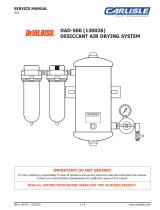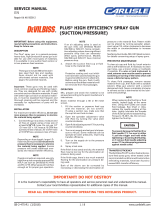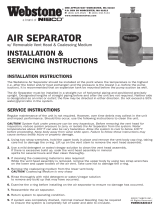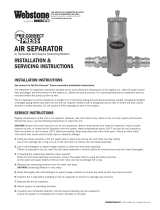
SB-6-159-H Page 7
MAINTENANCE - DESICCANT DAD-1
1. Replace the desiccant when the hu-
midity indicator changes to a pink
color. Remove the pipe plug at the
bottom of the tank. Allow the material
to drain into a two (2) gallon or larger
container.
2. Once all the material has been re-
moved, replace the pipe plug (see
"Note" following) and tighten securely
(air tight).
Note
Use PTFE tape on pipe plug
threads and all threaded fittings
to facilitate removal in the future.
Do not use loctite or any material
that may bond and make removal
difficult.
3. Replace the DAD-3 humidity indica-
tor paper (supplied with DAD-1 Des-
siccant) by removing the DAD-400
humidity indicator. Pry out the old
paper and push in the new paper
(printed side facing away from the
glass).
4. Remove the pipe plug on top of the
unit.
5. Using a funnel (suppplied with des-
iccant), fill the unit using DeVilbiss
Desiccant Material Part No. DAD-1
(19-0831) until full.
6. Replace the pipe plug (see "Note"
above) and tighten until air tight.
7. The humidity indicator will return to
a blue color within five minutes.
8. The desiccant material should be
disposed of properly.
9. Refer to the appropriate service
bulletin for checking the filters and
components.
Note
A desiccant Tune-Up Kit Part No.
DAD-600, is available. Contains
the following parts to completely
recondition a desiccant air station:
Part No. Description Qty.
Supplied
DAD-1 Desiccant 1
---
Humidity Indicator 1
HAF-6 #1 Filter Element 1
and O-Ring
DAD-8 Replacement Instructions (for filter
between the flow-thru regulator and the
desiccant tank air inlet: Replacing the air
filter is not normally needed. It is required
only when the filter has been damaged or
plugged because the unit was not properly
maintained.
10. Be sure air supply to unit is shut off
and bleed off all air pressure from the
DAD unit.
11. Make sure the desiccant material is
drained from unit per above instruc-
tions.
12. Disconnect the unit at the union.
Remove the filter bowls and filter ele-
ments from both the first and second
stage filters of the unit.
13. Use an open end 7/8" wrench and
remove the hex nipple between the
DAD tank and the flow-thru regulator.
The nipple should unscrew out of the
tank.
14. Using a needle nose pliers, remove
the wire screen in the tank fitting.
Note
If the retainer is plastic, use a 1/4"
square thread extractor or 1/4"
square bar stock to unscrew the
retainer out of the tank.
15. Use a #4 Phillips screwdriver and
reverse the above procedures to
install a new DAD-8 filter. Install
about halfway into the tank fitting.
16. Reverse procedure to reassemble.
Refill with desiccant.
DAD-8 Replacement Instructions (for the
filter between the air regulator and the
desiccant tank).
17. Be sure air supply to unit is off and
bleed all air from the DAD unit.
18. Be sure all desiccant material is
drained from the unit. Remove the
air regulator (11) from tank by placing
a 7/8" wrench on the tank bushing &
1-1/8" wrench on the regulator.
19. Remove the brass bushing from the
tank using a 7/8" wrench. The bush-
ing may have a stainless steel screen
attached. If so, cut the screen off
the bushing with a knife. It will be
replaced by the DAD-8 filter. If there
is no S/S screen attached, follow the
steps below.
Note
If the filter is plastic, use a 1/4"
square thread extractor or 1/4"
square bar stock to unscrew the
filter from the tank.
20. Use a #4 Phillips screwdriver and re-
verse the above procedures to install
a new DAD-8. Install about halfway
into the tank fitting.
Note
The air regulator can be installed
back on the tank or additional
piping can be installed to pipe
the air to a different location.
Remember that the volume of
air flow can be affected by the
pipe and distance to the new
location. All fittings are regular
pipe fittings.
21. Reverse procedure to reassemble.
Refill with desiccant.
22. Before placing unit back into service,
make sure plastic bowls and metal
bowl guards are properly installed
and securely locked in place.
23. Confirm automatic drain operates
properly after unit is in operation.
Replace if necessary.
Refer to SB-6 149 for further instructions.
ACCESSORIES
HAF-407
Mounting Bracket Assembly Kit
WARRANTY
This product is covered by DeVilbiss' 1 Year Limited Warranty.
DeVilbiss Sales and Service: www.devilbiss.com
DeVilbiss
DeVilbiss has authorized distributors throughout the world. For technical
assistance or the distributor nearest you, see listing below.
U.S.A./Canada Customer Service Office:
195 Internationale Blvd., Glendale Heights, IL 60139
Toll-Free Telephone: 1-800-992-4657 (U.S.A. and Canada only)
Toll-Free Fax: 1-888-246-5732
DeVilbiss Automotive Refinishing
DeVilbiss has authorized distributors throughout the world.
For equipment, parts and service, check the Yellow Pages
under “Automotive Body Shop Equipment and Supplies.”
For technical assistance, see listing below.
U.S.A./Canada Customer Service Office:
11360 S. Airfield Road, Swanton, OH 43558
Toll-Free Telephone: 1-800-445-3988 (U.S.A. and Canada only)
Toll-Free Fax: 1-800-445-6643




















